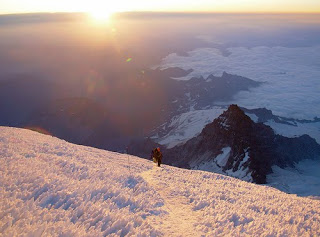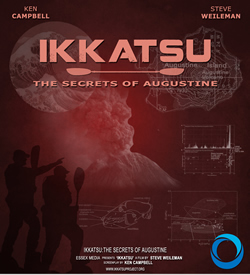Up the mountain with Edward Abbey – III
I often have difficulty getting to sleep at altitude, a combination of over-exhaustion and anxiety, and the night spent at Camp Schurmann is no exception. What keeps me awake on this occasion, however, is the wind. It begins shortly after we crawl into bed, just small puffs of a breeze at first, but it doesn’t take long for it to build into a raging blast. I fall in and out of fitful slumber, twenty minutes here, half-an-hour there, as do Tony and Dustin. The noise is deafening inside the tent and, as the wind buffets it about, we are thankful we have remembered to affix the extra guy lines to its sides before we turned in. We sleep through the alarms or, more likely, aren’t able to hear them above the crackling of the tent fabric. When I finally pull one of the watches over near my face, and turn on my headlamp, I am jolted full-awake by the hands on the watch face: 1:20 am. We’ve overslept.
We crawl out of our nylon cocoon into the blast of air. Dust and dirt swirl around us, filling our noses, eyes and ears as we take stock of the situation. A large lenticular cloud hovers on the peak, obscuring the summit, a sign of even more vigorous winds up top. We discuss the wisdom of continuing.
It is one of the hardest decisions to make, especially at this time of the morning, whether to go up the mountain as planned or turn in retreat, assuring ourselves that the mountain will be there for us another day. If we continue the ascent, our pace would be slowed, our footing less secure, in this infernal wind. I think of others who have chosen poorly in their decisions on this mountain: Willi Unsoeld, a veteran of the Himalayas and a world-renowned mountaineer, and Janie Diepenbrock, who died in a fall on the Ingraham glacier, in similar conditions, during an Evergreen State College trip in 1979; twenty-four-year-old David Taylor, who was caught in a storm in 1974, buried in an avalanche, and whose body has never been recovered. Most of all, I think of Delmar Fadden, a headstrong and energetic youth of twenty-two, who died in a fall on the Emmons glacier, just a few thousand feet up from where we stand now, during a solo climb in the winter of 1936. Fadden had a wealth of experience in the mountains despite his tender years, and knew well the dangers inherent in the climbing environment. The mountain had its own plans for him, however, and for reasons we can never know, he became a statistic. Perhaps he failed to listen to what the mountain was telling him.
We decide to light the stove, brew some hot chocolate, and see if the storm abates before making our final decision. Rather than risk an open flame in the swaying tent, we find a calm area in the lee of the shelter and take advantage of the eddy behind the wall. Soon, water is boiling, and the hot liquid is warming our chilled insides.
Instead of dying down, the wind increases in its fury, blowing perhaps forty or fifty miles-an-hour, with even more vigorous gusts. We return to the tents to sleep until dawn after we conclude that the summit will have to wait for us to return another time. We will descend in the morning, going out the way we came, back to the car, back to the world.
What is it that pushes us to these places? I still want to know. Why do we forsake the modern conveniences that have taken civilization so many years to perfect, to while away our precious time fighting gravity? “There comes a day when a man must hide. Must slip away from the human world and its clutching, insane and insatiable demands.” That’s a fact, Mr. Abbey. That sums it up.
“Every time I go anywhere out in the desert or the mountains, I wonder why I ever go back. I wonder why I should return. Someday I won’t.”











